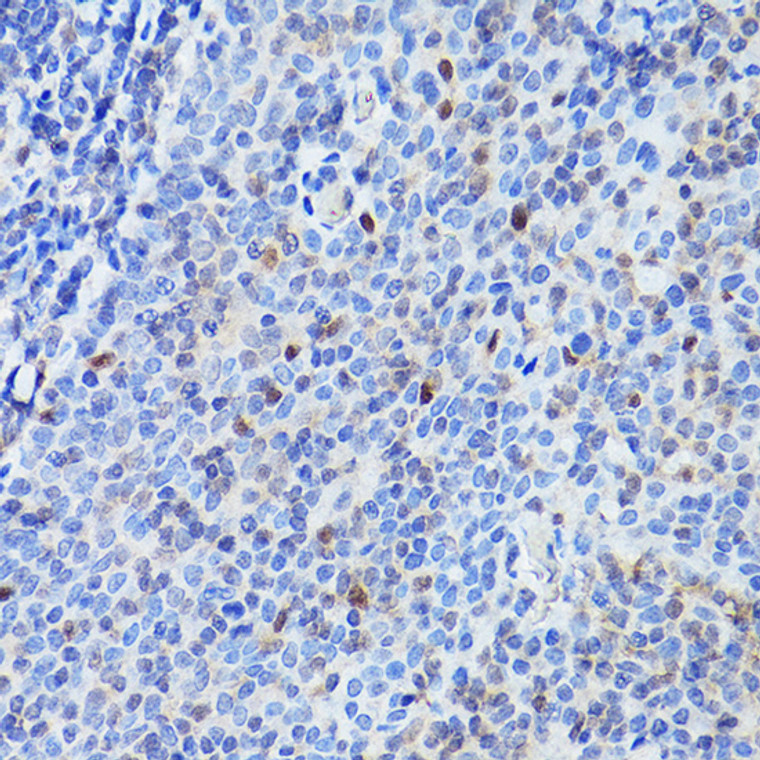| Host: |
Rabbit |
| Applications: |
WB/IHC |
| Reactivity: |
Human/Mouse |
| Note: |
STRICTLY FOR FURTHER SCIENTIFIC RESEARCH USE ONLY (RUO). MUST NOT TO BE USED IN DIAGNOSTIC OR THERAPEUTIC APPLICATIONS. |
| Short Description: |
Rabbit polyclonal antibody anti-SPI1 (17-98) is suitable for use in Western Blot and Immunohistochemistry research applications. |
| Clonality: |
Polyclonal |
| Conjugation: |
Unconjugated |
| Isotype: |
IgG |
| Formulation: |
PBS with 0.05% Proclin300, 50% Glycerol, pH7.3. |
| Purification: |
Affinity purification |
| Dilution Range: |
WB 1:500-1:1000IHC-P 1:50-1:200 |
| Storage Instruction: |
Store at-20°C for up to 1 year from the date of receipt, and avoid repeat freeze-thaw cycles. |
| Gene Symbol: |
SPI1 |
| Gene ID: |
6688 |
| Uniprot ID: |
SPI1_HUMAN |
| Immunogen Region: |
17-98 |
| Immunogen: |
Recombinant fusion protein containing a sequence corresponding to amino acids 17-98 of human SPI1 (NP_003111.2). |
| Immunogen Sequence: |
SEDLVPYDTDLYQRQTHEYY PYLSSDGESHSDHYWDFHPH HVHSEFESFAENNFTELQSV QPPQLQQLYRHMELEQMHVL DT |
| Tissue Specificity | In the bone marrow, concentrated in hematopoietic stem cell, lymphoid progenitor, myeloid lineage (granulocyte macrophage progenitors, classical dendritic cells, monocytes) and B-cell clusters. Among B-cells, predominantly expressed in pre-B1 cells. Expressed in germinal center B-cells. |
| Function | Pioneer transcription factor, which controls hematopoietic cell fate by decompacting stem cell heterochromatin and allowing other transcription factors to enter otherwise inaccessible genomic sites. Once in open chromatin, can directly control gene expression by binding genetic regulatory elements and can also more broadly influence transcription by recruiting transcription factors, such as interferon regulatory factors (IRFs), to otherwise inaccessible genomic regions. Transcriptionally activates genes important for myeloid and lymphoid lineages, such as CSF1R. Transcriptional activation from certain promoters, possibly containing low affinity binding sites, is achieved cooperatively with other transcription factors. FCER1A transactivation is achieved in cooperation with GATA1. May be particularly important for the pro- to pre-B cell transition. Binds (via the ETS domain) onto the purine-rich DNA core sequence 5'-GAGGAA-3', also known as the PU-box. In vitro can bind RNA and interfere with pre-mRNA splicing. |
| Protein Name | Transcription Factor Pu.131 Kda-Transforming Protein |
| Database Links | Reactome: R-HSA-8939236Reactome: R-HSA-9616222 |
| Cellular Localisation | Nucleus |
| Alternative Antibody Names | Anti-Transcription Factor Pu.1 antibodyAnti-31 Kda-Transforming Protein antibodyAnti-SPI1 antibody |
Information sourced from Uniprot.org
12 months for antibodies. 6 months for ELISA Kits. Please see website T&Cs for further guidance








